Mypasokey: Your Simple, Secure Path to Passwordless Login
If juggling passwords feels like spinning plates on a windy day, you’re not alone. Mypasokey is part of the movement to make logging in simple, safe, and fast—without typing passwords. Think of it like swapping a flimsy padlock for a smart key that only you can use. Let’s walk through what it is, why it’s better, and how to set it up across your devices.
What is mypasokey?

The quick definition
Mypasokey refers to a passwordless authentication method that replaces traditional passwords with device-bound credentials and biometrics like Face ID, Touch ID, or Windows Hello. Instead of entering a password, you verify yourself on your device, and your device does the secure handshake with the service. That makes login smoother and significantly harder for attackers to compromise.
Why it matters now
We’ve reached the limit of what complex passwords and endless resets can do. People reuse passwords, fall for phishing, and struggle with password managers. Mypasokey streamlines sign-in by anchoring your identity to a device and a secure biometric or PIN. The result? Faster logins, fewer phishing risks, and fewer password headaches across apps and platforms.
How mypasokey works under the hood

Cryptographic key pairs explained
Mypasokey uses asymmetric cryptography: your device generates a key pair—one private, one public. The private key stays on your device and never leaves. The public key goes to the website or app you’re registering with. When you try to sign in, the service sends a challenge that your device signs using the private key, proving it’s you without revealing the key itself.
Biometrics and device-bound credentials
Biometrics (like fingerprints or facial recognition) don’t get sent to websites. They simply unlock the credential on your device, which then handles the secure exchange. Your phone or computer becomes the gatekeeper, and services trust the cryptographic proof it provides.
The role of standards
Mypasokey is built on open authentication standards supported by major tech companies. These standards ensure credentials are bound to devices, resistant to phishing, and easy for developers to implement across browsers and platforms.
Benefits of using mypasokey

Strong security against phishing
Because there’s no password to steal and authentication is tied to your device and a cryptographic key, phishing websites can’t trick you into giving up your secret.
Faster, frictionless login experiences
No more typing, remembering, or resetting passwords. You tap, scan, or confirm, and you’re in—often within seconds.
Cross-device compatibility
Mypasokey works across Windows, macOS, iOS, and Android, with support in major browsers. That means you can register on one device and use it across your ecosystem.
Mypasokey vs. traditional passwords
Why passwords fail
Passwords rely on human memory and habits—which aren’t security’s best friends. People reuse credentials, pick predictable patterns, and skip password manager hygiene.
How passkeys change the game
Passkeys remove the user’s burden of memorization and block phishing by design. Device-held private keys can’t be exfiltrated by fake sites, and biometrics add convenience without sharing sensitive data externally.
Setting up mypasokey on different devices
Windows setup with Windows Hello
Enable Windows Hello (face, fingerprint, or PIN) in Settings, then use it to authenticate with supported browsers and apps.
macOS setup with Touch ID
On macOS, ensure Touch ID is active. Safari and other browsers support passkeys, letting you authenticate with a fingerprint.
iOS and Android setup with Face ID and biometrics
On iOS, Face ID/Touch ID unlocks your credentials during login. On Android, biometric prompts tie into the same model.
Browser integration
Most major browsers now support passkeys. Once enabled, you’ll see “Use passkey” options during login flows.
Using mypasokey at work and at home
Personal accounts
Enable passkeys on email, banking, and social apps. Your daily routine gets lighter: fewer password prompts, fewer resets, and lower phishing risk.
Enterprise use
Businesses benefit from stronger authentication without friction. Passkeys reduce phishing risk, cut helpdesk tickets, and simplify compliance.
Best practices for a bulletproof setup
Enable two-factor authentication (2FA) wisely
Even with passkeys, 2FA adds a layered defense—especially for critical accounts. Prefer app-based authenticators over SMS.
Recovery codes and account recovery plans
Recovery codes are your “spare keys.” Store them offline so you’re covered if you lose your device.
Device hygiene and backup strategies
Keep your OS and browsers updated, enable full-disk encryption, and protect your devices with strong local passcodes.
Common myths and misconceptions
“Biometrics are stored online”
Biometric data doesn’t leave your device. It’s used locally to unlock your credential, but the online service sees only cryptographic proof.
“Passwordless isn’t secure”
Passwordless done right is more secure because it cuts out phishable secrets and binds identity to a device you control.
Troubleshooting: What to do when something goes wrong
Lost device or broken sensor
If you lose your device, use recovery codes or a backup device to regain access, then revoke the lost device’s credentials.
Sync issues across devices
When credentials don’t appear on another device, verify you’re signed in to the same account and that passkey support is enabled.
Privacy: What mypasokey knows — and doesn’t
Data stored locally vs. on servers
Your private key lives on your device; servers store only the public key. Biometrics remain local, acting as the unlock mechanism.
Opt-in controls and transparency
You decide which devices hold credentials and can review or revoke them.
Future of identity: Where mypasokey is headed
Passkeys everywhere
Expect “Use a passkey” to appear across more services—banking, commerce, social, enterprise portals.
Beyond login: payments, physical access, and IoT
The same cryptographic trust model can extend to approving payments, unlocking doors, and authenticating to smart devices.
Quick start checklist
- Enable biometrics on your device.
- Create passkeys where available.
- Turn on 2FA and generate recovery codes.
- Test a login flow on a supported site.
Mypasokey vs. passwords: A quick comparison
| Feature | Passwords | Mypasokey (Passkeys) |
|---|---|---|
| Phishing resistance | Low | High |
| User effort | High (remember/reset) | Low (tap/scan) |
| Device binding | No | Yes |
| Biometric unlock | Rare | Common |
| Cross-platform support | Variable | Strong |
Conclusion
Mypasokey makes the internet feel lighter and safer. By anchoring your identity to your device and a secure biometric unlock, it strips away the worst parts of passwords—phishing, fatigue, and resets—and replaces them with a tap-and-go experience that actually raises your security bar. Whether you’re logging into banking, social media, or work apps, passkeys are the kind of upgrade that you notice immediately and appreciate every day. Start small on a few key accounts, enable 2FA and recovery codes, and you’ll wonder why you didn’t go passwordless sooner.
FAQs
- What exactly is mypasokey? It’s a passwordless authentication approach using device-bound credentials and biometrics.
- Is mypasokey more secure than passwords? Yes. It resists phishing and credential theft because there’s no password to steal.
- Do I need special hardware to use mypasokey? Most modern phones and computers already support biometrics like Face ID, Touch ID, or Windows Hello.
- Can I use mypasokey across different devices? Yes, it works across Windows, macOS, iOS, and Android.
- What happens if I lose my phone or laptop? Use recovery codes or a backup device to regain access, then revoke the lost device’s credentials.
- Are my fingerprints or face scans stored online? No. Biometrics stay on your device and are only used to unlock your local credential.
- Do all websites support mypasokey? Not yet, but support is growing rapidly.
- Should I still use two-factor authentication (2FA)? Yes. Pair passkeys with 2FA for critical accounts.
- Can businesses roll out mypasokey for employees? Absolutely. Enterprises use passkeys to reduce phishing risk and streamline logins.
- Is it hard to get started? Not at all. Enable biometrics, create passkeys, and you’ll be logging in with a tap in minutes.







